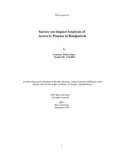Survey on impact analysis of access to Finance in Bangladesh

View/Open
Date
2020-09Publisher
BRAC UniversityAuthor
Papry, Amonyta ZahanMetadata
Show full item recordAbstract
Access to finance includes the provision of financial services to different categories of
deprived and low income groups at an affordable rate. This include access to deposits,
investments, and insurance, transfers and remittance facilities provided by formal financial
institutions.
In numerous other nations, comprehensive back for comprehensive development has ended
up an arrangement issue in Bangladesh taking after the worldwide monetary emergency in
2008. Over the past 10 a long time, concentrated of budgetary developing and get to money
related administrations has expanded. In cooperation banks and microfinance educate have
donated to developed concentrated.
Access to finance signifies the arrangement of managing an account administrations at
a reasonable fetched to the different segments of impeded and low-income bunches. These
include reserve funds, credit, protections, installments and settlement offices advertised to
those who tend to be banned by formal money-related education. Therefore, financial
inclusion means that individuals and businesses have access to useful and affordable financial
products and services that meet their needs in a reasonable and sustainable way: transactions,
payments, insurance payments, credit, and funds.
Bangladesh Bank has issued a set of guidelines to open farmers 'accounts, government social
safety net program accounts, opportunity fighters' unusual accounts, small life protection
accounts, road and working children's accounts, and student accounts, etc., to state-owned
commercial banks and specialized banks. Both from the supply and request sides, Bangladesh
As a controller of the money keeping division, Bangladesh bank allotted various rules /
circulars on the development of monetary administrations to underserved and un-served
section of the populations. In 2007, the total number of banks and their branches were 48 and
6717 individualistically. But now there are 60 banks and 10,114 branches in the country.
The main objective of the present overview was to assess the impact of the financial inclusion
measures taken by the Bangladesh Bank. Lion's share of the managed account interviewer
detailed that after building up a relationship with the budgetary teaching, they were initiated
to make reserve funds.
